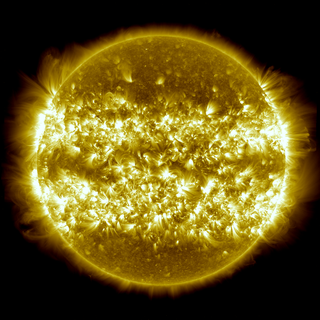NASA: video results of three-year observations of the Sun

NASA has published a four-minute video, obtained as a result of observations of the Sun of the Solar Dynamics Observatory ( SDO ) spacecraft for three years. The agency sets the goal of this mission to study the influence of the Sun on our planet and equipped the SDO with solid imaging equipment: the resulting image is 4096 × 4096 pixels in size. command post snapshot every 12 seconds, which is about 3 terabytes of data per day or 1 petabyte per year.
The pictures of the Sun, from which the video was collected, were taken in a wavelength of 171 angstroms (10 −10 m) (which corresponds to invisible ultraviolet radiation), and demonstrate solar matter with a temperature of about 600,000 K. its size - this is caused by the different position of the SDO relative to the Sun during the observation period.
Starting at about 2:37, the video shows a solar disk shot at a wavelength of 4500 angstroms, which corresponds to the visible range of the solar radiation spectrum, which allows us to see, so to speak, the "natural light" of the sun. In addition, a number of astronomical events can also be seen against the background of the Sun's disk:
')
- 00:30:24 Partial lunar eclipse. Almost an instant - about half the disk of the moon appears in the upper part of the sun.
- 01:11:02 The X-ray peak (flare) on the Sun, which occurred on August 9, 2011, with a maximum score of X6.9 for the 24th solar cycle.
- 01:28:07 Passage of Lovejoy comet on December 15, 2011.
- 01:51:07 One of the rare astronomical phenomena is the last (in time) passage of Venus through the solar disk on June 5, 2012. The following passage will occur only in 2117.
For amateurs and professionals, there is a much more detailed video (1920x1080, mov) of 3 GB in size, which can be downloaded here . On the same site, you can take ultra-quality (7282 x 4096, tif , 85 MB; or a little less than 4096 x 4096, jpeg , 14 MB; there is even less — images of the Sun in various formats are ideal for desktop wallpapers).
[ Source ]
Source: https://habr.com/ru/post/177705/
All Articles